New perk! Get after it with local recommendations just for you. Discover nearby events, routes out your door, and hidden gems when you sign up for the Local Running Drop.
Plan a dream getaway for non-running kids and spouses, without sacrificing trail time
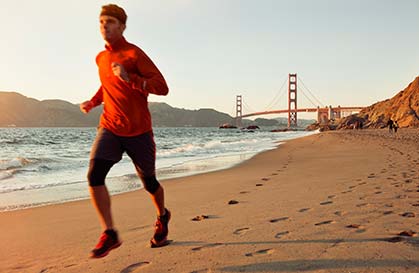
iStockPhoto.com
The snow is melting and the air is warming. In a few months the kids will be out of school, which means it will be time to pack everyone into the car and leave town on vacation. Whether you like beaches or snowy mountains, theme parks or museums, you’re looking to rest, relax and catch up on family time.
But family fun that the whole family actually enjoys is sometimes hard to come by. Crowded amusement parks, bumper-to-bumper traffic, sunburnt, hungry kids, your toddler realizing Mickey Mouse is much scarier in person … sometimes parents need a little vacation from their vacation. Thankfully, many of the country’s top family-vacation spots are not far from great running trails. Here are 10 getaways to consider this summer or fall.
1. Orlando, Florida
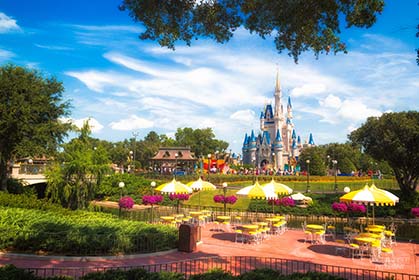
Photo by Christian Lambert Photography / Creative Commons 2.0
Orlando is home to the theme-park trifecta: Walt Disney World, Universal’s Islands of Adventure and Sea World. The kids are begging to go, and so you steel yourself for a week of crowds, junk food and singing cartoon characters.
Luckily, the greater Orlando area offers trail runners some fun of their own. Myriad state and national conservation areas within an hour’s drive of Orlando offer runners and hikers access to unique salt marsh ecosystems, prairies and forests replete with a diversity of birds and other small mammals. What the terrain lacks in technicality it makes up for in beauty and uniqueness.
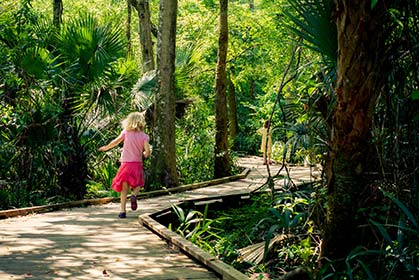
Wekiwa Springs State Park. Photo by Flickr user Rain0975 / Creative Commons 2.0
What: A sunny vacation close to the beach, with something for everyone
When: Between Labor Day and Thanksgiving is usually the quietest time, as most kids have returned to school. Weather-wise, January through March, between the wet season and the bug season, is ideal
Things to do:
>The Disney World Resort includes the Magic Kingdom, Animal Kingdom, Disney’s Hollywood Studios and Epcot, with rides, shows and interactive displays that allow you to “travel” to a different country—or into your child’s favorite Disney movie.
>On Universal’s Islands of Adventure, visitors can choose from Marvel Super Hero Island, Seuss Landing, the Looney Toons-themed Toon Lagoon, dinosaur-themed Jurassic Park and, of course, the Wizarding World of Harry Potter.
>Kids might also enjoy kayaking, stand-up paddle boarding, scuba diving, visiting the Kennedy Space Center or watching the Cirque du Soleil. Parents can enjoy a round of golf on their recovery day.
Trails:
>The 6,000-acre Seminole Ranch Wildlife Management Area, 20 miles east of Orlando, contains 4.3 miles of the Florida National Scenic Trail, through river marsh, pasture, hardwood forest and cabbage-palm hammocks.
>The Hal Scott Regional Park and Preserve, 25 miles east of Orlando, offers roughly 17 miles of trails through flatwoods and open prairie along the Econlockhatchee River.
>Wekiwa Springs Sate Park, just outside Orlando, in Apopka, Florida, has a 10-mile loop that passes over gentle to moderate terrain through a floodplain forest of scrub oak and mixed hardwoods. The trail is open September through May, and visitors must pay a state-park fee at the entrance.
>Shingle Creek Regional Park, in Orlando proper, is open year round, and boasts the 5-mile Shingle Creek Regional Trail.
2. Southern California
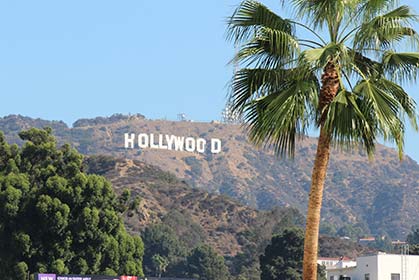
Photo by Shinya Suzuki / Creative Commons 2.0
Southern California: land of sun, beaches, theme parks and movie stars. Disneyland may be your kids’ “happiest place on earth,” but that doesn’t mean adults have to suffer in silence. The surrounding area boasts enough urban wilderness—and real wilderness—to make mom and dad happy, too.
The Mediterranean climate means mild winters and hot, dry summers—ideal conditions for all-year trail running. The Santa Monica Mountains National Recreation Area and the Angeles National Forest, home to a section of the Pacific Crest Trail, both offer over 500 miles of backcountry trails through native chaparral, sagebrush and oak scrub forest, with everything from steep, mountainous climbs to rolling forest paths and coastal overlooks.
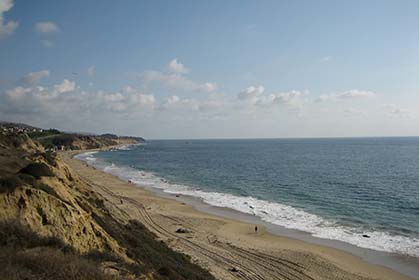
Crystal Cove State Park. Photo by Eugene Kim / Creative Commons 2.0
What: Sun, beaches, roller coasters, Disney characters and movie set tours. Oh, and trail running
When: July through August is the most popular time to visit southern California, though also the hottest. April, May, September and October are typically still warm and sunny, as well as less crowded.
Things to do:
>Disneyland is a perennial favorite with the kids—a place to ride roller coasters and come face-to-face with their favorite Disney characters. In nearby Buena Park, Knott’s Berry Farm (a Wild West theme park) offers a more old-school experience.
>At Hollywood’s Universal Studios, the family can tour a movie set, ride a movie-themed roller coaster and, of course, take a picture at the famous Hollywood sign.
>In Los Angeles, visit the Graff Lab, a graffiti park where the art changes every day. Even further south is Legoland California. At San Diego Sea World and the San Diego Zoo, kids can watch whale and dolphin shows, visit the zoo’s famous giant pandas and have breakfast with the koalas.
Trails:
>Crystal Cove State Park, 24 miles from Anaheim, boasts 17 miles of singletrack and gravel trails. Higher trails afford vistas of the Pacific Ocean and surrounding backcountry, while lower trails travel through a canyon, along Moro Creek. Trails are marked easy, moderate, difficult and strenuous. No dogs are allowed on the trails.
>Big Santa Anita Canyon, in the Angeles National Forest, 22 miles from Hollywood, offers over 30 miles of alternately forested and exposed singletrack.
3. San Francisco
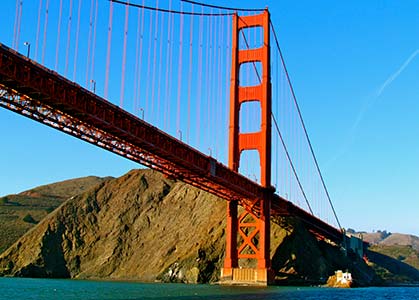
Photo by Jeff Gunn / Creative Commons 2.0
Don’t like theme parks, but still crave sunshine and kid-friendly activities? The Bay Area boasts a plethora of museums, historical landmarks and educational, entertaining activities for your whole family to enjoy.
Still, sometimes it’s nice to be able to explore a new city at your own pace. Between federal and state parks, there are over 200 miles of nearby trails through the state’s famous redwood trees, as well as oak woodlands, prairie, coastal cliffs and long, flat beaches. Just pack some extra layers: coastal weather can fluctuate unexpectedly, and fog is common.
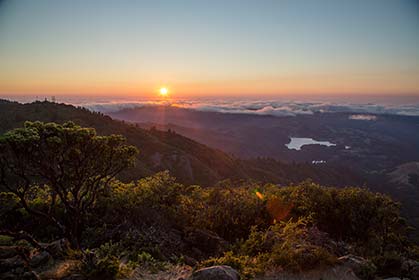
Sunset from the top of Mt. Tamalpais. Photo by Kyle Greenberg / Creative Commons 2.0
What: Coastal fun without the theme-park crowds.
When: Autumn is often the warmest and driest time of year in the Bay Area.
Things to do:
>San Francisco has a number of kid-friendly museums. The Exploratorium features many science exhibits, including the Tactile Dome; entirely in the dark, it requires participants to navigate using their sense of touch. The Children’s Creativity Museum houses educational, hands-on art and technology exhibits. Cross the bay to Sausalito to the Bay Area Discovery Museum for another interactive learning experience for all ages—from toddlers to adults—and fantastic views of the Golden Gate Bridge.
>Kids (and their parents) will also love a visit to the San Francisco Zoo or Alcatraz Island, a civil-war fort that served as a prison from 1934 to 1963. Flying kites on Fisherman’s Wharf and riding a cable car are also Bay Area must-do’s.
Trails:
>Within San Francisco proper, Presidio Park boasts 24 miles of trails along the coast.
>Get your vert in at 922-foot Twin Peaks. Dirt and grass trails offer scenic overlooks of San Francisco and the bay.
>Roughly 50 miles outside San Francisco, Portola Redwood State Park boasts 18 miles of trails in forested but accessible terrain.
>Across the Golden Gate Bridge, roughly 18 miles from San Francisco, Mount Tamalpais State Park offers over 50 miles of trails, and connects to a 200-mile trail network outside the park. The 2,571-foot peak offers views of San Francisco, the Marin County Hills, the Farallon Islands and Mount Diablo.
4. Oahu, Hawaii
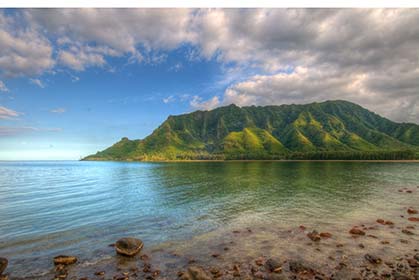
Photo by Emlyn Stokes / Creative Commons 2.0
In a word, Oahu is dramatic. Volcanic peaks and ridgelines, coated a lush green, rise from the ocean. The beaches are white, the water is turquoise and the sunlight (and humidity) is intense. Oahu, Hawaii’s third-largest island, is home to the state’s capital city, Honolulu. The island boasts world-class beaches and resorts.
If you get tired of just sitting on the beach, there are miles of singletrack just minutes away. Home of the H.U.R.T. 100 race, Oahu’s trail networks traverse the island’s mountainous interior, wending through dense forests filled with unique island plant life. Rocks, roots and significant climbs are the hallmarks of the terrain.
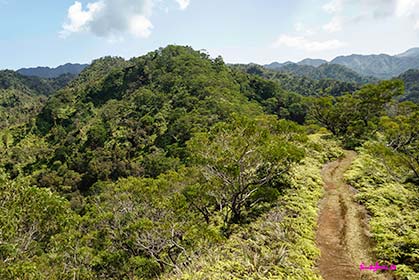
Manana Trail in the Ewa Forest Reserve. Photo by Leonard S. Jacobs / Creative Commons 2.0
What: A topical vacation that’ll keep everyone warm, tan, and happy.
When: The average temperature in Hawaii is 80 degrees Fahrenheit, all year round. April through October is the dry season, while November through March is the wet season, though the islands typically never see rain for more than three days in a row.
Things to do:
>Waikiki and Lanikai are two of the island’s most popular beaches, and are known for their gentle surf, good for small children. Waikiki has easy access to a number of restaurants and bars, while Lanikai tends to be slightly less crowded.
>Older kids might enjoy zip-lining or taking a surfing lesson.
>The whole family can take a trip to the Honolulu Zoo or the World War II Valor in the Pacific National Monument at Pearl Harbor.
>In the hottest part of the day, head to town for some shave ice, a traditional Hawaiian sweet.
Trails:
>The Ewa Forest Reserve, located 18.8 miles from Waikiki, features several trails through dense forest. For the Manana Trail (11-13 miles) and the Waimano Trail (5 miles), park on Komo Mai Drive.
>The Kuli´ouóu Ridge Trail winds 2.25 miles up Ko´olau ridge, switchbacking through lush forests with frequent views of the ocean. A steep, rooted section leads to the summit. Local tradition is to run to the top, back down and to the top again, for a total of 10 miles. The trailhead off Kalaau road is 9.3 miles from Waikiki.
>The Honolulu Mauka Trail System, 2.4 miles from Waikiki, has nine miles of forested trails. The trails begin at the Hawaii Nature Center, off Makiki Heights Drive.
5. Washington, D.C.
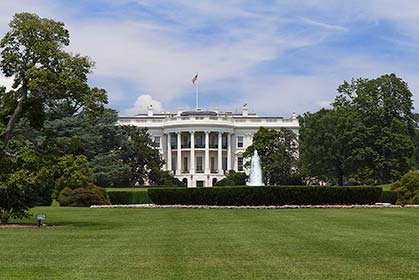
Photo by Stefan Fussan / Creative Commons 2.0
From government buildings, museums and national monuments to diverse restaurants and a vivacious nightlife, Washington, D.C., has something for the scientist, the history buff, the artist and, yes, even the nature lover.
Though it has all the hustle and bustle of a city, our nation’s capital boasts the extensive trail network of a true country town. Rock Creek Park and Great Falls offer easy access to shaded trails along rivers and through forests, while many other historic and scenic trails along the Potomac River provide a choose-your-own-adventure escape into the wilds of urban D.C.
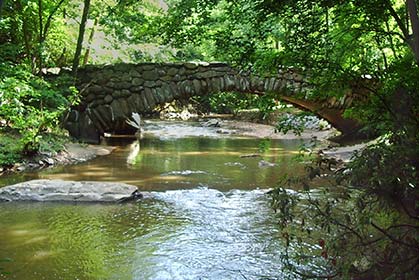
Boulder Bridge in Rock Creek Park. Photo by Flickr user NatureServe / Creative Commons 2.0
What: An educational and inspiring trip to the nation’s capital.
When: Fall and spring are ideal visiting times: warm, but without the humidity and frequent thunderstorms of summer. In April, the city hosts its annual Cherry Blossom Festival.
Things to do:
>Take a tour of the White House and Capitol Hill, home to landmarks like the U.S. Capitol Building, the Supreme Court and the Library of Congress.
>Another must-see is the National Mall and Memorial Parks, where kids can run in the grass and the whole family can visit the Vietnam Memorial, World War II Memorial, Lincoln Memorial and Martin Luther King, Jr., Memorial, among others. Kids will love riding to the top of 555-foot Washington Monument.
>D.C. also has a high concentration of museums, including the Smithsonian National Air and Space Museum, the media-themed Newseum and the Holocaust Museum.
Trails:
>Located in the heart of D.C., Rock Creek Park is easily accessible and has over 32 miles of trails. The Western Ridge Trail and the Valley Trail traverse the east and west sides of the park and connect to a web of other singletrack trails, dirt roads and paved bike paths.
>Fifteen minutes outside of D.C, 800-acre Great Falls Park has 15 miles of trails along the eponymous 20-foot waterfall, the site of an old canal on the Potomac River. A paved path links three viewpoints and connects to more technical forest trails.
>History-minded trail runners can explore a section of the Potomac Heritage National Scenic Trail, which runs along the western bank of the Potomac River from Virginia to Pennsylvania over the route that George Washington once rode.
>On the eastern side of the Potomac lies the Chesapeake and Ohio Canal Towpath, a shaded asphalt, dirt and gravel path following the old towpath of a canal that once transported lumber and other goods to the Alleghany mountains and the Ohio lakes region.
6. Williamsburg, Virginia
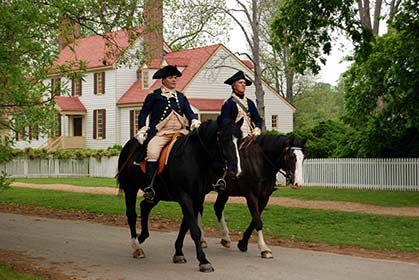
Photo by Harvey Barrison / Creative Commons 2.0
In Williamsburg you can take a trip back in time to the world of colonial America, when wool was spun at home, candles were made on the stove, dignitaries rode horses instead of cars and important documents were signed with quill and ink.
Once you’re ready to step back into the 21st century, but need a break from 21st-century crowds, sneak away to one of the many state parks and wildlife conservation areas in the surrounding area. Williamsburg lies within driving distance of Virginia’s southern tip, with its historical and ecologically diverse trails. Estuaries of the Chesapeake Bay snake through the area, rich in marine and bird life and rife with history from the days when the land was first settled by Europeans.
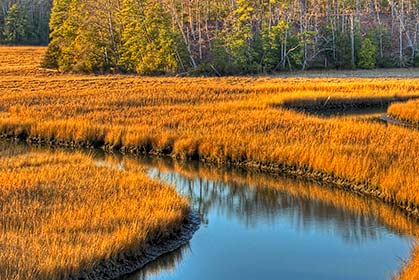
York River State Park, near Williamsburg. Photo by Flickr user vastateparkstaff / Creative Commons 2.0
What: An informative and historical trip to the site of the first European settlement in the country.
When: Virginia enjoys a mid-Atlantic climate, which means four distinct seasons. Summer is the most popular time to visit, though fall has beautiful foliage.
Things to do:
>Take the kids to Colonial Williamsburg, the faux-colonial city where visitors get a hands-on experience of what it was like to live in colonial times. Visit blacksmiths and tailors, witness revolutionary battles in the streets, take part in a witch trial, try your hand at colonial-era dances and tour several museums full of centuries-old artifacts.
>At historic Jamestown Settlement in Jamestown, Virginia, watch an ongoing archaeological investigation. In the Ed Shed, kids can participate in the archaeological process by sifting through historically significant debris and finding 3D-printed replicas of artifacts.
>Virginia Beach, a popular summer beach getaway, is also within a day’s drive.
Trails:
>Located just north of the Chesapeake Bay, on the banks of the York River, York River State Park’s estuarine environment hosts a mix of salt-water and fresh-water species and unique salt-tolerant plant life. The park has 30 miles of trails through marshland and prairie.
>New Quarter Park is a seven-mile point-to-point trail located within Williamsburg proper. The trail also has access to the York River and Queens Creek. Terrain is forested, with some roots.
>Chickahominy Wildlife Management Area, 20 miles from Williamsburg along the banks of the Chickahominy River, offers mowed wildlife corridors that are also open to hikers and runners. Deer, turkeys, rabbits and waterfowl are common sights, as well as diverse marine life in the many creeks and streams.
7. Niagara Falls
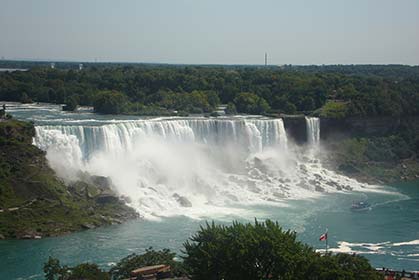
Photo by Stacey Gitto / Creative Commons
If Orlando has the theme-part trifecta, then the Northeast has the mountain-range trifecta: New York’s Adirondack mountains, Vermont’s Green Mountains and New Hampshire’s White Mountains, all within five hours of one another. Each area offers runs for all abilities, through fir and birch forests, around high mountain lakes and over ridgelines.
If you’re passing through New York, stop at Niagara Falls, the country’s oldest state park and site of three roughly 170-foot waterfalls, which collectively dump about 750,000 gallons of water per second. Afterward, while the kids visit the aquarium or eat lunch at one of the nearby restaurants, you can take off for an afternoon run on one of the several trail systems along the Niagara River.
What: A trip to a world-renowned tourist destination overlooking a series of waterfalls on the Niagara River, on the border between Canada and the United States.
When: Summer is the most popular time to visit Niagara Falls, though fall is cooler, less crowded and has the benefit of fall foliage.
Things to do:
>The Niagara Gorge Discovery Center has a rock climbing wall, multi-screen video display and hands-on exhibits about the river and waterfall.
>Kids will also love the Aquarium of Niagara, where you can watch the sea lions swim with their trainers, and the Niagara Adventure Theater, where the 30-minute film “Niagara: Legends of Adventure” screens on a daily basis.
>The Castellani Art Museum houses a large collection of paintings from the Hudson River School, known for their stunning landscapes.
Trails:
>The Niagara Gorge Trail System is a network of interconnecting loops through Whirlpool State Park, Devil’s Hole State Park, DeVaux Woods State Park and Artpark State Park. The trails, steep in places, travel along the upper gorge and descend to the river’s edge, offering views of the upper river and the class V rapids and spinning pools of water downstream from the falls.
8. Midcoast Maine

Camden Harbor. Photo by Roman Boed / Creative Commons 2.0
Maine is a popular summer-camp destination, which means the inevitable—and exhausting—parents’ weekend, filled with barbecues, art shows, pick-up softball games and musicals starring thirteen year-olds. But don’t write off the state because of it.
Maine’s coast is part of the Intercoastal Waterway, the oceanic thoroughfare that stretches from Maine to Florida, and the beach towns of Camden and Rockport are major hubs for commercial and recreational boats alike. Several state and national parks in the area feature technical and moderate trails for those wishing to disappear into the pines for a few hours and emerge to views of the sailboats and fishermen in the surrounding harbors and islands.
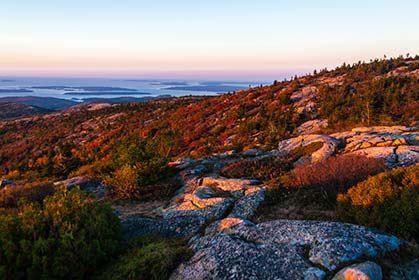
Early morning light on Cadillac Mountain, Acadia National Park. Photo by Paul VanDerWerf / Creative Commons 2.0
What: A sea-side New England vacation, where the seafood is fresh and the trails are endless.
When: Escape the heat and the crowds by planning your visit for late summer or early fall. Pack an extra layer: the temperatures drop at night.
Things to do:
>Take a tour of one of the historic wooden sailboats in Camden Harbor.
>Sample Maine’s famous Gifford’s ice cream.
>Take a tour of one of Maine’s many microbreweries. Marshall Wharf Brewery, in Belfast, has a full menu of craft beers and a harbor-view restaurant.
>At the end of July, Rockland hosts the Maine Lobster Festival, a weekend full of lobster rolls and entertainment.
Trails:
>In the southern area of the state, Camden Hills State Park offers miles of trails up Mount Battie, Mount Megunticook and the surrounding hills, where pine forests give way to rocky, exposed ridgelines that overlook Camden, Rockport and the Penobscot Bay. Megunticook Trail, the most direct route to the summit of Mount Megunticook, travels one mile and climbs roughly 1,000 feet. The 2.5-mile Ridge Trail traverses a ridgeline from Ocean Lookout to the Maiden Cliffs.
>In neighboring Lincolnville, the 3.5-mile Bald Rock Mountain Trail covers similar terrain up another peak in Camden Hills State Park.
>Farther north, Acadia National Park offers 125 miles of trails that vary from easy to technical, through forests, along beaches and cliff bands, across summit ridges and down steep, rocky gullies. Run up Cadillac Mountain before sunrise and be the first person to see the sun in the continental U.S.
9. Stowe, Vermont
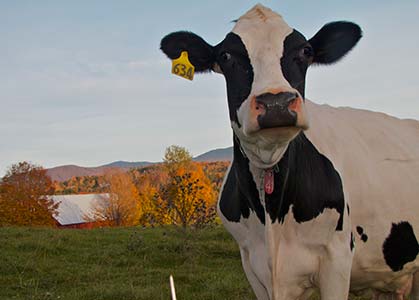
Photo by Scott Teresi / Creative Commons 2.0
Nestled in the Champlain Valley, between Mount Mansfield and several other peaks in Vermont’s Green Mountains, Stowe is part ski town and part farm country, with rolling evergreen hills and idyllic dairy-cow pastures. You may know it from the musical “The Sound of Music”; it became the new home of the Von Trapp family when they fled Nazi Austria.
Visit in the fall to enjoy foliage, fresh apple cider and local maple syrup, and explore the local mountains and state forests, which offer miles of moderate and technical trails, stream crossings and rocky scrambles through mixed hardwood forests.
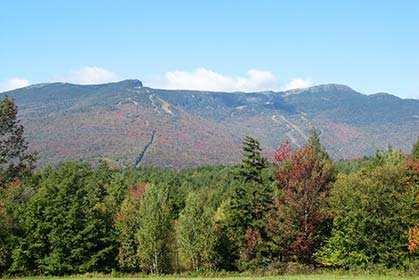
Mount Mansfield, Vermont. Photo by Flickr user Redjar / Creative Commons 2.0
What: A quaint, scenic New England town.
When: Fall is the best time of year for trail running, as the days are warm but not humid, and the fall colors are in full force.
Things to do:
>Take the kids to Shelburne Farms, a fully functional farm with a hands-on learning center for kids to milk cows and pet lambs, chickens and pigs.
>Tour of the Ben and Jerry’s Factory, which shows you how their ice cream is made, and how they come up with new flavors—and a bonus taste test at the end!
>At the Cold Hollow Cider Mill, watch how cider is pressed and sample some local maple syrup and cheddar cheese.
>Mom and dad might like a tour of the Rock Art Brewery, one of the many craft breweries on the Vermont Beer Trail.
Trails:
>Trapp Family Lodge, the refurbished homestead of the Von Trapp family (yes, that Von Trapp family), is located just a few miles outside of downtown Stowe and has over 40 miles of runnable, rolling trails, which are groomed for cross-country skiing in the winter and open for biking and other uses in the off season.
>The 2.8-mile Stowe Pinnacle Trail, which starts from Upper Hollow Road in Stowe, goes through a field before turning into rooty, forested singletrack that gets progressively steeper toward the summit.
>Mount Mansfield, the highest mountain in Vermont, lies roughly 40 miles from Stowe in the heart of Mansfield State Forest. The Sunset Ridge Trail wends a strenuous six miles through mixed hardwood forest and across an exposed ridgeline with views of the surrounding Champlain Valley.
10. Mount Rushmore
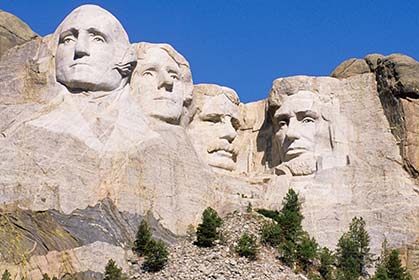
Photo by Flickr user Chascar / Creative Commons 2.0
It all sounded so good at the time: a family road trip to go see iconic Mount Rushmore. While you’re at it, might as well stop in Yellowstone National Park and maybe the Grand Canyon, too. But by the time you get to South Dakota, you’ve been in the car for 10 hours and the kids are cranky.
Luckily, there are various state parks throughout the Black Hills region. Generations of ranchers and loggers created trails before the land was put into federal and state protection. Dirt and grass singletrack winds through streams, gulches, high prairies and herds of grazing buffalo.

Watching deer in Custer State Park, South Dakota. Photo by Flickr user Navin75 / Creative Commons 2.0
What: One of the nation’s most iconic monuments and national forests.
When: Late summer through fall.
Things to do:
>Mount Rushmore National Memorial features 60-foot sculptures of former U.S. Presidents George Washington, Thomas Jefferson, Theodore Roosevelt and Abraham Lincoln. There is also a scenic walkway and restaurant on site.
>While you’re in the area, visit Rapid City’s Dinosaur Park—a park with several life-sized dinosaur replicas—or tour Bear City USA, a park where adult and baby black bears, buffalo, elk and wolves can be viewed from the safety of your car.
Trails:
>The South Dakota Centennial Trail spans 111 miles of rugged singletrack through the Black Hills; 22 miles of it pass through Custer State Park. The French Creek Natural Area, a designated scientific, educational and recreational area in the same park, has no marked trails but runners and hikers are welcome to find their own route along the creek and surrounding gorge.
>The George S. Mickelson Trail offers 109 miles of gentler terrain through Black Hills National Forest. There are multiple trailheads, the most convenient at Tracy City Park in Hill City.